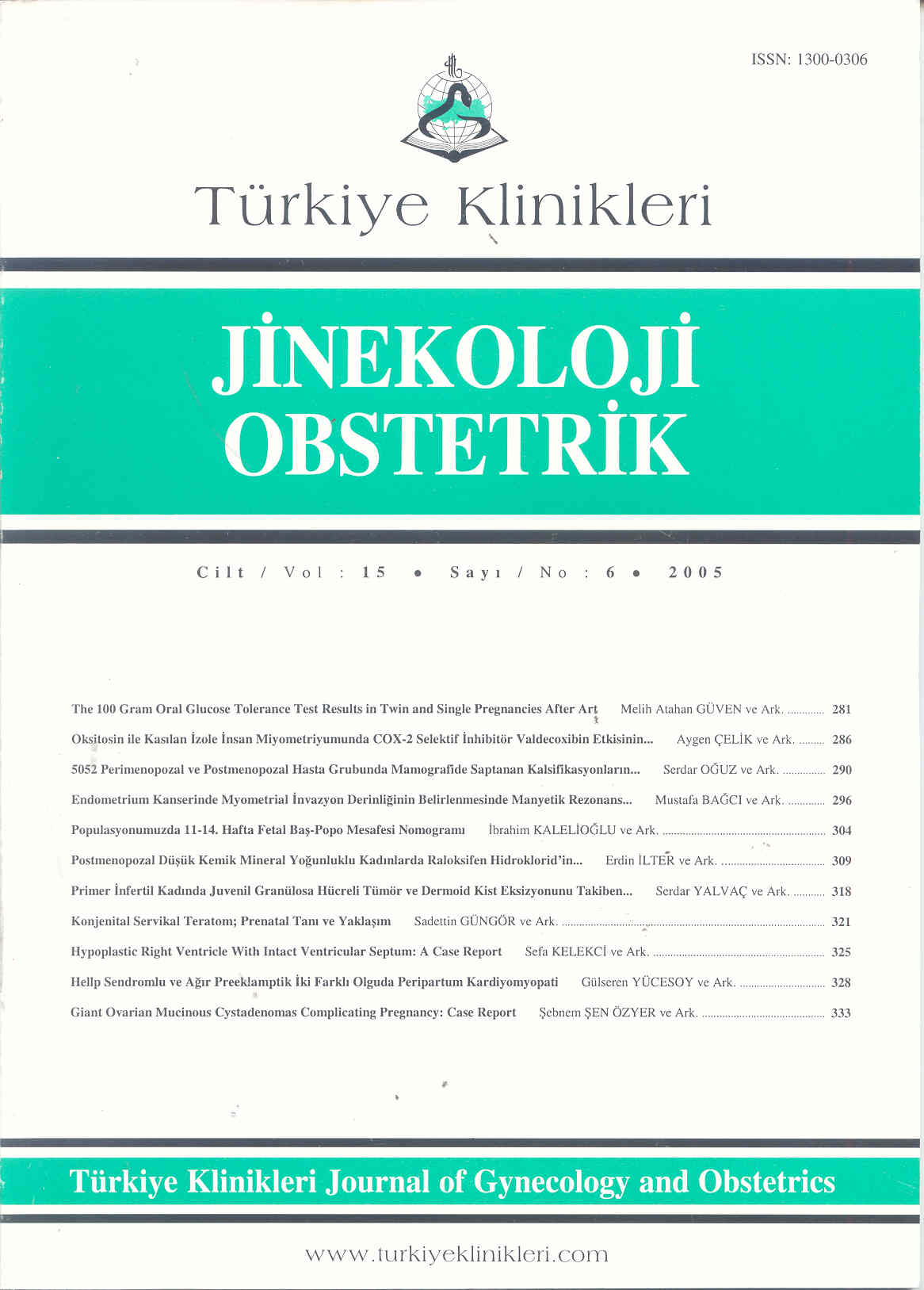Open Access
Peer Reviewed
ORIGINAL RESEARCH
3203 Viewed1053 Downloaded
The 1 Gram Oral Glucose Tolerance Test Results in Twin and Single Pregnancies After Art
Yardımcı Üreme Tekniği Sonrası, Tekil Ve İkiz Gebeliklerdeki 1 Gram Oral Glikoz Tolerans Testinin Sonuçları
Turkiye Klinikleri J Gynecol Obst. 2005;15(6):281-5
Article Language: TR
Copyright Ⓒ 2025 by Türkiye Klinikleri. This is an open access article under the CC BY-NC-ND license (http://creativecommons.org/licenses/by-nc-nd/4.0/)
ÖZET
Amaç: Bu araştırmanın amacı; yardımcı üreme tekniği ile elde edilen, tekil ve ikiz gebelerdeki 100 gr oral glikoz tolerans sonuçlarını karşılaştırmaktı. Gereç ve Yöntemler: Yüz tekil in vitro fertilizasyon/intrastoplazmik injeksiyon- Embryo transferi gebeliği (İVF/İSİ-ET) (Grup 1), 72 ikiz İVF/İSİ-ET gebeliği (Grup 2) ve 128 tekil spontan gebelik (Grup 3), geriye dönük olarak 100 gr oral glikoz tolerans testi sonuçları için karşılaştırıldı. Bulgular: İVF/İSİ-ET ile elde dilen tekil gebelerin birinci ve ikinci saatte elde edilen plazma glikoz düzeyleri, spontan tekil gebelerin sonuçlarından daha yüksek olmasına rağmen, İVF/İSİ-ET sonucu oluşan tekil ve ikiz gebelerin 100 g sonuçları benzerdi. Sonuç: İVF/İSİ-ET sonucu meydana gelen tekil gebelerde, glikoz intoleransının düzeyi spontan tekil gebeliklerden elde edilen değerlere göre daha yüksek olmakla beraber, İVF/İSİ-ET sonucu elde edilen tekil ve ikiz gebeliklerin glikoz toleransları benzerdi.
Amaç: Bu araştırmanın amacı; yardımcı üreme tekniği ile elde edilen, tekil ve ikiz gebelerdeki 100 gr oral glikoz tolerans sonuçlarını karşılaştırmaktı. Gereç ve Yöntemler: Yüz tekil in vitro fertilizasyon/intrastoplazmik injeksiyon- Embryo transferi gebeliği (İVF/İSİ-ET) (Grup 1), 72 ikiz İVF/İSİ-ET gebeliği (Grup 2) ve 128 tekil spontan gebelik (Grup 3), geriye dönük olarak 100 gr oral glikoz tolerans testi sonuçları için karşılaştırıldı. Bulgular: İVF/İSİ-ET ile elde dilen tekil gebelerin birinci ve ikinci saatte elde edilen plazma glikoz düzeyleri, spontan tekil gebelerin sonuçlarından daha yüksek olmasına rağmen, İVF/İSİ-ET sonucu oluşan tekil ve ikiz gebelerin 100 g sonuçları benzerdi. Sonuç: İVF/İSİ-ET sonucu meydana gelen tekil gebelerde, glikoz intoleransının düzeyi spontan tekil gebeliklerden elde edilen değerlere göre daha yüksek olmakla beraber, İVF/İSİ-ET sonucu elde edilen tekil ve ikiz gebeliklerin glikoz toleransları benzerdi.
ANAHTAR KELİMELER: İkiz gebelik, tekil gebelik, IVF, gestasyonel diabetes mellitus
ABSTRACT
Objective: The aim of the study is to investigate if ART per se, and twinning in ART pregnancies have any effects on 100-g oral GTT results. Material and Methods: One hundred singleton In Vitro Fertilization/IntraCytoplasmic Injection-Embryo Transfer (IVF/ICSI-ET) pregnancies (Group 1), 72 twin IVF/ICSI-ET pregnancies (Group 2), and 128 singleton spontaneous pregnancies (Group 3) were retrospectively compared with respect to the results of 100-g oral glucose tolerance test. Results: Singleton IVF/ICSI-ET pregnancies and twin IVF/ICSI-ET pregnancies were similar regarding the results of 100-g oral glucuse tolerance test, although first and second hour plasma glucose levels were higher in singleton IVF/ICSI-ET pregnancies than in singleton spontaneous pregnancies. Conclusion: The present findings indicate that glucose tolerances in singleton and twin IVF/ICSI-ET pregnancies were similar, although singleton IVF/ICSI-ET pregnancies have a higher level of glucose intolerance than that of spontaneous singleton pregnancies.
Objective: The aim of the study is to investigate if ART per se, and twinning in ART pregnancies have any effects on 100-g oral GTT results. Material and Methods: One hundred singleton In Vitro Fertilization/IntraCytoplasmic Injection-Embryo Transfer (IVF/ICSI-ET) pregnancies (Group 1), 72 twin IVF/ICSI-ET pregnancies (Group 2), and 128 singleton spontaneous pregnancies (Group 3) were retrospectively compared with respect to the results of 100-g oral glucose tolerance test. Results: Singleton IVF/ICSI-ET pregnancies and twin IVF/ICSI-ET pregnancies were similar regarding the results of 100-g oral glucuse tolerance test, although first and second hour plasma glucose levels were higher in singleton IVF/ICSI-ET pregnancies than in singleton spontaneous pregnancies. Conclusion: The present findings indicate that glucose tolerances in singleton and twin IVF/ICSI-ET pregnancies were similar, although singleton IVF/ICSI-ET pregnancies have a higher level of glucose intolerance than that of spontaneous singleton pregnancies.
MENU
POPULAR ARTICLES
MOST DOWNLOADED ARTICLES





This journal is licensed under a Creative Commons Attribution-NonCommercial-NoDerivatives 4.0 International License.










